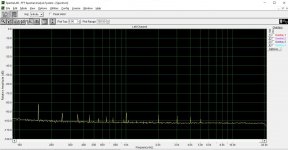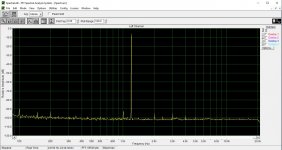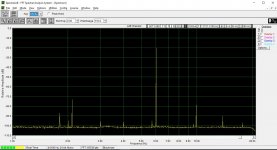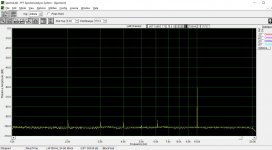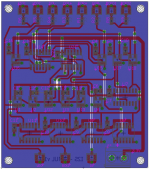Well, RFBRW, to me it seems that you either have to share something great here,
I don't have to do diddly squat. There is no point. It's all been done before.
Do you currently use, or do you plan to use a 1541A based DAC?.
Many years ago the adjoining studio to the video post production house where I worked had a visit from AMS Neve. They brought along their mastering converters, based on the TDA1541A/SAA7220P, and by all accounts they were something special. Also had an AudioFile to play with for a while, also TDA1541A/SAA7220P based, liked the sound but not very practical. I still have an AMS Neve board somewhere that I might one day use.
Many years ago the adjoining studio to the video post production house where I worked had a visit from AMS Neve. They brought along their mastering converters, based on the TDA1541A/SAA7220P, and by all accounts they were something special. Also had an AudioFile to play with for a while, also TDA1541A/SAA7220P based, liked the sound but not very practical. I still have an AMS Neve board somewhere that I might one day use.
Hmm This is a thread about the ultimate NOS DAC using TDA1541A . When you are referring to a DAC using a SAA7220P, you are a referring to a DAC that uses digital filter. Not at all the same...
Hmm This is a thread about the ultimate NOS DAC using TDA1541A . When you are referring to a DAC using a SAA7220P, you are a referring to a DAC that uses digital filter. Not at all the same...
Perhaps you should let FOOBAR/SOX resampling crowd in on that little secret.
Hmm This is a thread about the ultimate NOS DAC using TDA1541A . When you are referring to a DAC using a SAA7220P, you are a referring to a DAC that uses digital filter. Not at all the same...
I agree. There a few of contributors who miss the point of this thread with their irrelevant posts and general hostility to the TDA1541 based on experiences of commercial products and who have never listened to some of the later implementations.
Perhaps you should let FOOBAR/SOX resampling crowd in on that little secret.
So you believe that a digital filter chip such as SAA7220P can do the same as a resampler with a full blown CPU behind?
Sowter, Lundahl or other? Please give some more details, like I/V resistance, transformer inductance and turns ratio. Incorrect values could lead to early LF cutoff.I also tried a transformer coupled solution, but I did not like it compared to a simple resistor I/U converter stage. The analog amplifier stage was the same in both cases, even the resistor type was the same in the I/U and in the secondary of the trafo. The values were different of course. I felt loss in the bass region although the mids and hights were smoother a bit.
Sowter, Lundahl or other? Please give some more details, like I/V resistance, transformer inductance and turns ratio. Incorrect values could lead to early LF cutoff.
Yes, you cannot be dismissive of all transformers in this way.
I have no issues with the bass, mid or treble using my Sowter transformers and given the cost of them, I would not expect to.
I will say that they do require a reasonable signal so sticking to the recommended I/V resistor of 100R seems to produce the best sq. Reducing the I/V below 75R does have an audible adverse effect.
Using 'any old transformer' is likely to lead to poor results and a wrong conclusion.
I agree. There a few of contributors who miss the point of this thread with their irrelevant posts and general hostility to the TDA1541 based on experiences of commercial products and who have never listened to some of the later implementations.
I suggest that the TDA1541 haters start their own thread rather than continue polluting this one.
It might be entitled:
"Why we hate the TDA154x dacs" or something similarly catchy.
Sowter, Lundahl or other? Please give some more details, like I/V resistance, transformer inductance and turns ratio. Incorrect values could lead to early LF cutoff.
1, Sowter 1465. The secondary was connected parallel and to a 220 ohm z-foil.
2, without transformer - 47 ohm z-foil after the 1541
In both cases the analog amplification was done by a tube circuit with ~25* gain.
Maybe you were listening to the difference between two very different ways to load the TDA1541A. If you use 220 on the secondary you get a load on the TDA1541A of 200/25 = 8 Ohm (secondary in parallel) . And one of the advantages with the transformers is you do not need so much gain after it and high gain stages tend to have their own sonic signature.1, Sowter 1465. The secondary was connected parallel and to a 220 ohm z-foil.
2, without transformer - 47 ohm z-foil after the 1541
In both cases the analog amplification was done by a tube circuit with ~25* gain.
I would say you should try it , as it is designed for, with a much higher secondary resistor , in 1:10 configuration and lower or no gain after it.
1, Sowter 1465. The secondary was connected parallel and to a 220 ohm z-foil.
2, without transformer - 47 ohm z-foil after the 1541
In both cases the analog amplification was done by a tube circuit with ~25* gain.
Do you mean 220r across the secondary? That's way too small.
You should not need 25x gain with a transformer due to the step up ratio doing this for you.
"HOW TO CALCULATE THE I/V RESISTOR (example)
Current out = +/- 2 mA = 4 mA p-p = 4 / 2.82 mA= 1.43 mA
Configuration: Primary coils in parallel. Seconday coils in series. Ratio = 1:10
Secondary current = 0.143 mA
Secondary load resistor for line level (0.775V) = 0.775 / 0.000143 = 5420 Ohms. Allow 25% for copper loss. Use 6.8K Ohms
Configuration: Primary coils in parallel. Seconday coils in parallel. Ratio = 1:5
For line level out use 3.3K Ohms secondary load. For increased output level increase load in proportion."
My 9545 (earlier version of the 1465) does not need amplification with 100R I/V although I am using two 1541s in balanced mode so +6db over a single chip. I have just the right amount of bass.
Secondaries in series with about 10k load.
I repeated my previous FFT tests, this time powering the external USB soundcard from batteries, and powering the USB/I2S adaptor from external wall plug (there is an onboard stabilizer). Signal source: REW Generator 1198Hz, -6dBfs and -3dBfs. I used different computers for signal generator and analyzer. First picture is the baseline, second is 100R I/V resistor, -3dBfs, third is 100R I/V -6dBfs, fourth is 50R I/V -3dBfs.
3rd harmonic is visible with 100R, but it disappeared in noise with 50R I/V resistor.
3rd harmonic is visible with 100R, but it disappeared in noise with 50R I/V resistor.
Attachments
I repeated my previous FFT tests, this time powering the external USB soundcard from batteries, and powering the USB/I2S adaptor from external wall plug (there is an onboard stabilizer). Signal source: REW Generator 1198Hz, -6dBfs and -3dBfs. I used different computers for signal generator and analyzer. First picture is the baseline, second is 100R I/V resistor, -3dBfs, third is 100R I/V -6dBfs, fourth is 50R I/V -3dBfs.
3rd harmonic is visible with 100R, but it disappeared in noise with 50R I/V resistor.
They look good to my eyes but what happens at 10Khz and at lower levels?
I'm thinking of the claimed increase in distortion caused by not adhering to the 25mv output compliance. (the 3rd harmonic with 100riv is still around -85db and won't be audible but does it increase more at lower levels and higher frequencies?)
Last edited:
Nasty things come at higher frequencies, but there is no analog reconstruction filter at the DAC output. 6kHz -20dBfs, 10kHz -40dBfs, 10kHz -60dBfs.
Yes, that's true but even so, you compare the results with fft of sine waves on vinyl, which despite the appalling surface noise, poor dynamic range and alarming distortion figures, I still prefer. (can't be bothered cleaning my LPs of dog hairs or I'd listen to them a lot more)
I think digital audio processing to achieve perfection sterilises the sound, just as excessive video processing gives an artificial & flat image on many HD & UHD tvs.
Hi,
this is the current status of I2S to sign board. I ordered some PCBs but did not receive them yet. Will update once I get them.
View attachment 734060
Constructive comments and ideas are appreciated.
Looks fine to me. Hope you get the PCB's soon. If it works as planned, I hope very much to be able to buy a bare PCB ...😉
Well too much and used without thinking , then you are so right.Yes, that's true but even so, you compare the results with fft of sine waves on vinyl, which despite the appalling surface noise, poor dynamic range and alarming distortion figures, I still prefer. (can't be bothered cleaning my LPs of dog hairs or I'd listen to them a lot more)
I think digital audio processing to achieve perfection sterilises the sound, just as excessive video processing gives an artificial & flat image on many HD & UHD tvs.
Do you too use a CRT as projector?

Sure, once I'll get it to work 😉If it works as planned, I hope very much to be able to buy a bare PCB ...😉
- Home
- Source & Line
- Digital Line Level
- Building the ultimate NOS DAC using TDA1541A
